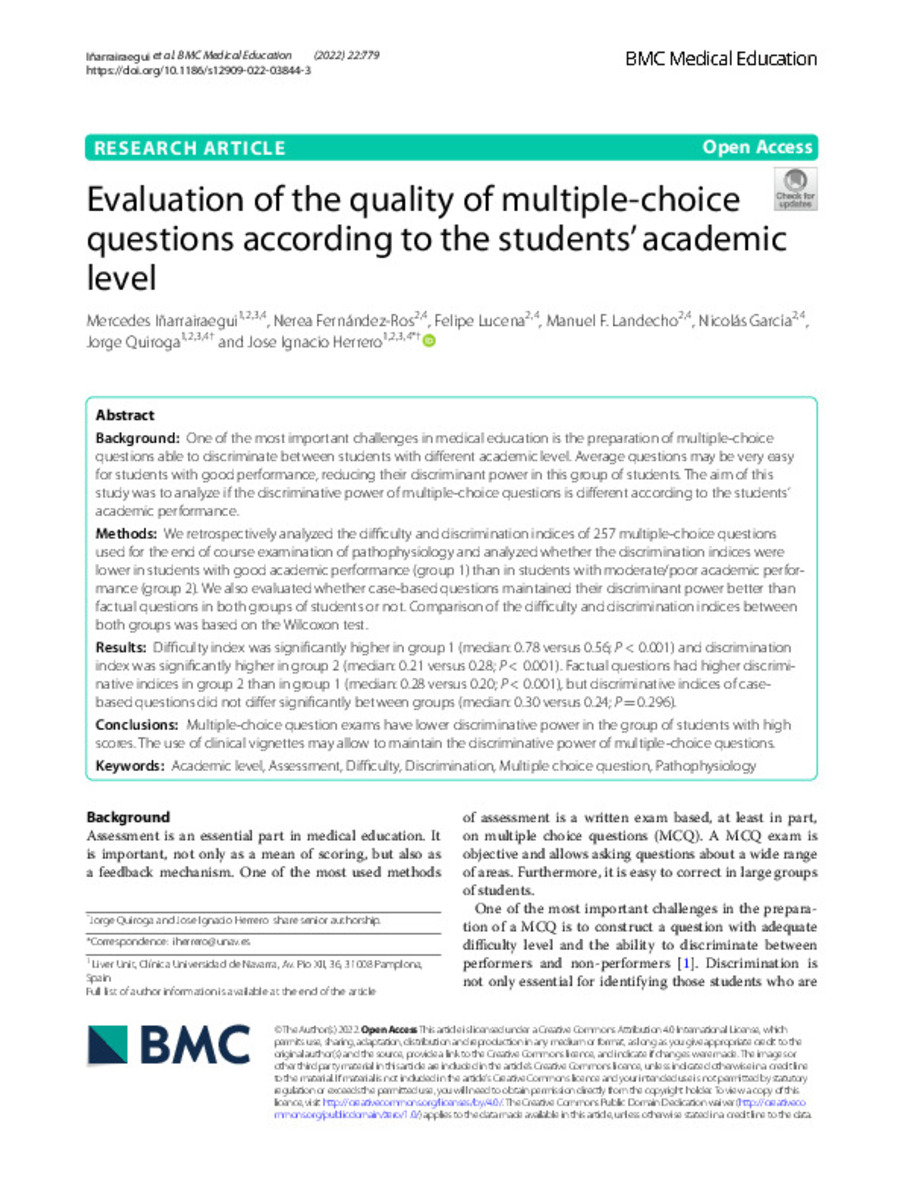Full metadata record
| DC Field | Value | Language |
|---|---|---|
| dc.creator | Iñarrairaegui, M. (Mercedes) | - |
| dc.creator | Fernandez-Ros, N. (Nerea) | - |
| dc.creator | Lucena-Ramírez, J.F. (Juan Felipe) | - |
| dc.creator | Landecho, M.F. (Manuel F.) | - |
| dc.creator | Garcia, N. (Nicolás) | - |
| dc.creator | Quiroga, J. (Jorge) | - |
| dc.creator | Herrero, J.I. (José Ignacio) | - |
| dc.date.accessioned | 2024-02-09T09:47:54Z | - |
| dc.date.available | 2024-02-09T09:47:54Z | - |
| dc.date.issued | 2022 | - |
| dc.identifier.citation | Iñarrairaegui, M. (Mercedes); Fernandez-Ros, N. (Nerea); Lucena-Ramírez, J.F. (Juan Felipe); et al. "Evaluation of the quality of multiple-choice questions according to the students’ academic level". BMC Medical Education. 22, 2022, 779 | es |
| dc.identifier.issn | 1472-6920 | - |
| dc.identifier.uri | https://hdl.handle.net/10171/68962 | - |
| dc.description.abstract | Background: One of the most important challenges in medical education is the preparation of multiple-choice questions able to discriminate between students with diferent academic level. Average questions may be very easy for students with good performance, reducing their discriminant power in this group of students. The aim of this study was to analyze if the discriminative power of multiple-choice questions is diferent according to the students’ academic performance. Methods: We retrospectively analyzed the difculty and discrimination indices of 257 multiple-choice questions used for the end of course examination of pathophysiology and analyzed whether the discrimination indices were lower in students with good academic performance (group 1) than in students with moderate/poor academic perfor‐ mance (group 2). We also evaluated whether case-based questions maintained their discriminant power better than factual questions in both groups of students or not. Comparison of the difculty and discrimination indices between both groups was based on the Wilcoxon test. Results: Difculty index was signifcantly higher in group 1 (median: 0.78 versus 0.56; P< 0.001) and discrimination index was signifcantly higher in group 2 (median: 0.21 versus 0.28; P< 0.001). Factual questions had higher discrimi‐ native indices in group 2 than in group 1 (median: 0.28 versus 0.20; P< 0.001), but discriminative indices of case- based questions did not difer signifcantly between groups (median: 0.30 versus 0.24; P=0.296). Conclusions: Multiple-choice question exams have lower discriminative power in the group of students with high scores. The use of clinical vignettes may allow to maintain the discriminative power of multiple-choice questions. | es_ES |
| dc.language.iso | eng | es_ES |
| dc.publisher | BMC | es_ES |
| dc.rights | info:eu-repo/semantics/openAccess | es_ES |
| dc.subject | Materias Investigacion::Ciencias de la Salud::Hepatología | es_ES |
| dc.subject | Academic level | es_ES |
| dc.subject | Assessment | es_ES |
| dc.subject | Difculty | es_ES |
| dc.subject | Discrimination | es_ES |
| dc.subject | Multiple choice question | es_ES |
| dc.subject | Pathophysiology | es_ES |
| dc.title | Evaluation of the quality of multiple-choice questions according to the students’ academic level | es_ES |
| dc.type | info:eu-repo/semantics/article | es_ES |
| dc.description.note | This article is licensed under a Creative Commons Attribution 4.0 International License, which permits use, sharing, adaptation, distribution and reproduction in any medium or format, as long as you give appropriate credit to the original author(s) and the source, provide a link to the Creative Commons licence, and indicate if changes were made. The images or other third party material in this article are included in the article’s Creative Commons licence, unless indicated otherwise in a credit line to the material. If material is not included in the article’s Creative Commons licence and your intended use is not permitted by statutory regulation or exceeds the permitted use, you will need to obtain permission directly from the copyright holder. To view a copy of this licence, visit http://creativecommons.org/licenses/by/4.0/. The Creative Commons Public Domain Dedication waiver (http://creativeco mmons.org/publicdomain/zero/1.0/) applies to the data made available in this article, unless otherwise stated in a credit line to the data. | es_ES |
| dc.identifier.doi | 10.1186/s12909-022-03844-3 | - |
| dadun.citation.publicationName | BMC Medical Education | es_ES |
| dadun.citation.startingPage | 779 | es_ES |
| dadun.citation.volume | 22 | es_ES |
Files in This Item:
Statistics and impact
Items in Dadun are protected by copyright, with all rights reserved, unless otherwise indicated.






